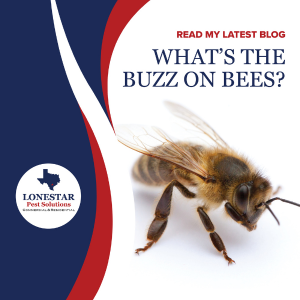


What’s the Buzz on Bees?
What’s the buzz on bees?
Bees and wasps are a common sight when the weather gets warmer, and flowers and plants begin to bloom. But despite their essential role in nature, they can be a nuisance around homes and businesses creating anxious customers and threatening human life.
Bees and wasps are related, with approximately 20,000 species in North America and more than 800 types in Texas alone. The most common of these pests include honeybees, bumble bees, carpenter bees, yellow jackets, hornets, mud daubers, and wasps.
Though generally not aggressive, bees and wasps will sting if they feel endangered. For example, if you are too close to a nest, and wearing bright colors, or wearing cologne or perfume, they may sting.
However, some types of bees are less threatening than others. Stingless bees, as the name suggests, don’t have stingers, and cannot harm humans and animals, just like male bumble bees and male carpenter bees. Among the female species, carpenter bees are the most docile and least likely to sting. Female honeybees and bumble bees will sting, but only when provoked.
So, what should you do if you see a nest forming? Foremost, don’t panic. Take a moment to assess the situation: is there a hive nearby or is it a visiting colony? Bees are most active during the day and less active in late evening and night.
Bees and wasps are valuable members of the ecosystem, pollinating plants, flowers, and food sources, and naturally controlling the insect population. But if you do see a nest somewhere too close for comfort, here’s what to do:
Take a picture of the nest and send it to Lonestar Pest Solutions’ office via text to 210-334-1446. We will be happy to identify the nest and make a recommendation for control/service.
Ouch! What to do if you’ve been stung
– Don’t panic. Calmly walk away from the area where you were stung. Though bees can sting only once. Wasps can sting multiple times.
– Identify the location of the sting and remove the stinger promptly to minimize pain and swelling.
– Don’t use tweezers! This will force more venom from the stinger into your skin. Instead, use your fingernail or catch it with a piece of gauze.
– Wash the area with soap and water.
– Apply ice to reduce swelling. If the swelling appears in your face or neck, you have nausea, hives, dizziness, or difficulty breathing, go to the emergency room immediately.
– Take over-the-counter pain relievers to alleviate discomfort.
Leave your buzzing pests to the professionals. Contact us at 210-653-4250 or lpsinfo@lonestarpestsolutions.com to learn how we can provide solutions to alleviate pests around your home or business.

Recent Comments